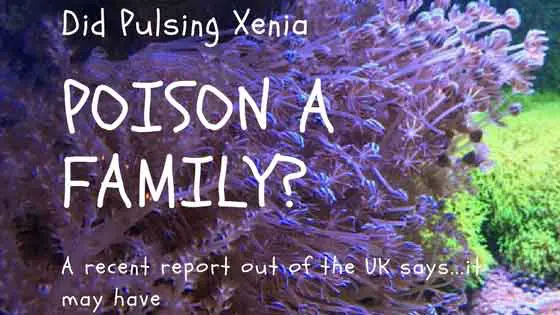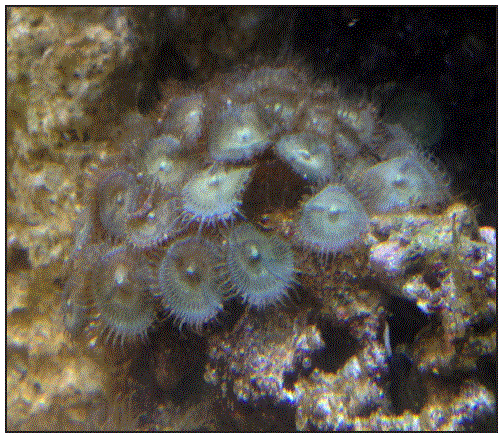The aquarium world has been buzzing about recent reports of palytoxin poisoning. It seems to be swirling because of some news reports like this one:
In that article, the report was that Chris Matthews, age 27, was taken to the hospital, along with a slew of other family members and rescue workers, because they had come down with flu-like symptoms–only worse. They couldn’t regulate their temperature and they had trouble breathing and concentrating.
Even the dogs were sick. Which, in my mind, might have been a blessing in disguise–because the dogs wouldn’t have had the flu with them. I wonder and hope that this might have been one of the things that tipped them off that something else was wrong.
Yikes!
Very scary.
In this report, it is mentioned that Chris was cleaning out a tank–moving the rocks to another container and scraped one of the rocks clean. This is where the story takes off, like wildfire, because the report was that the pest coral he was cleaning off was NOT listed as palythoa or a zoanthid, but rather:
“It’s a pest coral called pulsing xenia that you grow in areas where you can’t get anything else to thrive.”
That’s right, folks, pulsing Xenia.

Please read more about the real risks and health issues with palytoxin here
Sympathies for a real issue
Before I continue, let me get this out there first. I feel terrible about Chris, his family, his pets and the rescue workers who helped him and got sick. Palytoxin is serious, it is deadly, and we really need to be careful. Poisoning doesn’t happen that often, but it does happen and it could happen to any of us.
Skepticism that it was truly caused by pulsing xenia corals.
Ok, with that truly important human sympathy out of the way, I have to share my skepticism with you.
I’m not skeptical that the people were genuinely hurt. I’m super happy they got help. I’m not skeptical that the issue was scrubbing and moving the rocks. That is common in other reports of poisoning too. I’m not skeptical that the owner somehow mistook palythoa for Xenia corals.
What I am, otherwise curious about, is whether palythoa were present and he didn’t know. Perhaps the xenia was growing over palythoa (and the palys were releasing the toxins), or perhaps the palys were somewhere else on the rock and were scrubbed off, releasing the toxin.
How did the xenia coral ‘get’ the palytoxin in it, in the first place?
Previous proof of palytoxin
The United States Centers for Disease Control published a report in 2012 that looked back at 10 palytoxin poisoning cases and found the poison in…you guessed it…zoanthids of some type were always thought to be the culprit.
Another journal reported poisoning through a cut in the skin from a parazoanthus species.
This study, titled: Palytoxin-Containing Aquarium Soft Corals as an Emerging Sanitary Problem, has a section 1.1 that lists palytoxin-producing organisms:
The original source of PLTX was a soft coral, Palythoa toxica, collected in Hawaii. Throughout the years, it has also been identified in other species belonging to the genera Palythoa and Zoanthus…In 1995, a PLTX-like molecule was identified in benthic dinoflagellates of the genus Ostreopsis… to explain PLTX’s presence in phylogenetically-different species, some authors proposed bacteria as producing organisms and a possible common source of these toxins… However, a clear definition of the actual producing organism of PLTX is still a matter of debate.
This article gives an extensive review of the cases of poisoning. While not all of the cases involved toxicology and analysis of the corals in question, it was always thought to be a zoanthus coral.

Admittedly, many of these previous reports do not have conclusive evidence that it was always transferred by a zoanthus species, but that is certainly a commonly held belief. Nowhere before, that I could find, was it speculated to have come from xenia–or from a tank that was thought to be free from zoanthids. That doesn’t completely rule it out, but it does make me…well…skeptical of the conclusion in this case in the U.K.
Commentary on the poisoning
I am not a toxicologist, marine biologist, coral expert or poison expert. I’m simply a reef nerd, with a blog, so reader beware. I do want to point out, however, that if this truly was palytoxin poisoning from pulsing xenia, it would be the first report of it that I’m aware of.
I can’t point to my own research of the chemical composition of the tissues of pulsing xenia, or my deep knowledge of similar compounds, or how, possibly, the bacteria that produce the toxin in palys might have migrated into the tissue of the Xenia in question.
I also don’t want to minimize the VERY REAL health and safety issues that family faced. Regardless of my speculation about the source of the poisoning, it was real and it happened.
As the details of this case get examined further, I may be proven wrong. And that’s okay. I just want to caution you to carefully consider all the facts when making up your own mind. I encourage you to use this news story to figure out ways you can be safer when handling your live rock and corals. How you can minimize the creation of aerosols in your tank and how you can improve ventilation throughout your tank.
However, don’t declare a witch hunt xenia corals, quite yet
A final note on safety
I do think that the CDC report said it best–and who am I to suggest I know any better.
Activities that could potentially produce aerosols (e.g., scrubbing or using hot water to remove zoanthids) should be undertaken with caution. Patients A, B, and C did not handle any of the corals directly; rather, they were present in the home shortly after the introduction of palytoxin-containing zoanthids to the aquarium…evidence-based recommendations on appropriate respiratory protection or handling best practices will not be possible.
What they’re saying is that they don’t know exactly what to tell you, in order to be safe, but just know that you don’t just get sick from touching the toxin, you can get sick from handling the rocks.

So what should you do about it?
So what should you do if you think you have zoanthid, parazoanthid, palythoa or even pulsing xenia corals in your tank?
Well, the CDC didn’t say exactly what you should do–and I’m not going to step in front of them on that–but I do think it’s worth pointing out that removing the rocks and the corals from your tank may create ‘an event’ where the poison if it is in your tank, could become airborne.
If you do decide you need it ‘out of your house’, I encourage you to do so with as much ventilation as is reasonable and get it all the way out of the house. At this point, stirring things up could be worse (for the time being) than letting it go, unless you have palytoxin acutely in your air…
What am I doing about it?
I’m just trying to get some balance out about the story and I’m waiting for more information. I’m not pulling out any of my rocks or corals just yet…
Enough from me. What’s your reaction to all of this? Please leave a comment below:




Leave a Reply